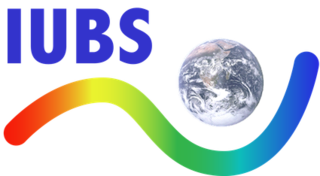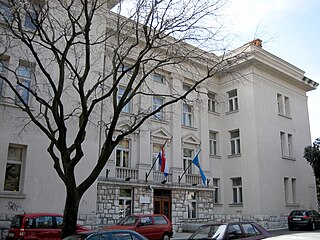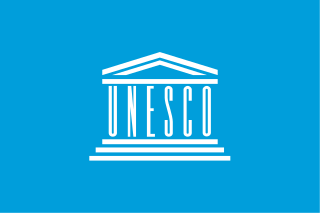
The Aristotle University of Thessaloniki is the second oldest tertiary education institution within Greece. Named after the philosopher Aristotle, who was born in Stageira, about 55 km east of Thessaloniki, it is the largest university in Greece and its campus covers 230,000 square metres in the centre of Thessaloniki, with additional educational and administrative facilities elsewhere.

The Lifelong Learning Programme 2007–2013 was the European Union programme for education and training.

The International Union of Biological Sciences (IUBS) is a non-profit organization and non-governmental organization, founded in 1919, that promotes the biological sciences internationally. As a scientific umbrella organization it was a founding member of the International Council for Science (ICSU).
The Europaeum is a network of eighteen universities in Europe. It was conceived of in 1990–1991 by Lord Weidenfeld and Sir Ronnie Grierson and they persuaded Roy Jenkins, who had just become Chancellor of the University of Oxford, to push this initiative in conjunction with the universities of Leiden, and Bologna. It has subsequently been supporting the "advancement of education through the encouragement of European studies in the University of Oxford and other European institutions of higher education having links with Oxford."

University College Ghent, commonly known as HoGent, is the largest university college in Flanders, with three faculties, one School of Arts and over 17,000 students as of 2022. Its establishment in 1995 is the outcome of two successful mergers that involved sixteen Belgian institutions of higher education. Many had been influential leaders in higher education for several decades. The current faculties are spread over the city center of Ghent and Aalst.

The University of Rijeka is in the city of Rijeka, Croatia, with faculties in cities throughout the regions of Primorje, Istria and Lika.

The Agence universitaire de la Francophonie is a global network of French-speaking higher-education and research institutions. Founded in Montreal, Quebec, Canada in 1961, as the Association des Universités Partiellement ou Entièrement de Langue Française (AUPELF), the AUF is a multilateral institution supporting co-operation and solidarity among French-speaking universities and institutions. It operates in French-speaking and non-speaking countries of Africa, the Arab world, Southeast Asia, North and South America, Polynesia, the Caribbean, Central, Eastern and Western Europe. As of 2020, the AUF has 1,007 members distributed throughout francophone countries on six continents. It is active in 119 countries, and represented by regional offices and information centers on campuses and in institutes. The Association receives funding from the Organisation internationale de la Francophonie (OIF), and its headquarters are located at the Université de Montréal, Quebec.

Basak Senova is an art curator, writer and designer from Istanbul, Turkey. She lives and works in Vienna since 2017.
Scholars at Risk (SAR) is a United States-based international network of academic institutions organized to support and defend the principles of academic freedom and to defend the human rights of scholars around the world. Network membership includes over 530 higher educational institutions in 42 countries.

John Thackara is a British-born writer, advisor and public speaker. He is known as curator of the celebrated Doors of Perception conference for 20 years, which started in Amsterdam. He is a senior fellow at the Royal College of Art in London.
The European Union's Erasmus Mundus programme aims to enhance quality in higher education through scholarships and academic co-operation between the EU and the rest of the world. The three main objectives of the programme are linked to the internationalisation of students, staff, curricula and research; ensure an influence on the development of practice in Special Education Needs and inclusive education; and to develop international collaborative networks, projects and research.
The European Association for International Education (EAIE) is a European centre for expertise, networking and resources in the internationalisation of higher education. It is a non-profit, member-led organisation serving individuals actively involved in the internationalisation of their institutions through training, conferences, research and knowledge acquisition and sharing. The EAIE is based in Amsterdam, The Netherlands, and has approximately 3000 members from over 80 different countries,the majority of which are located in Europe.
Since being founded in 1975, the European Nuclear Society (ENS) has grown to become the largest society in Europe for science, engineering and research in support of the nuclear industry. ENS's membership consists of national nuclear societies from 22 European countries, and additionally, Israel. Within the membership there are also stakeholder representatives for nuclear technology and research businesses, with around 60 corporate members. ENS exists to promote the advancement of peaceful uses of nuclear energy on an international level, encouraging networking between countries and facilitating meetings to support global communication on scientific and technical affairs. ENS also supports education and training in engineering, promotes international standardisation in the nuclear industry, coordinates the activities of the member organisations and develops the expertise and capability needed for the future of the industry. One of ENS's activities is organising conferences and workshops, providing a platform for international forums to exchange knowledge, experience, ideas and scientific developments.

The United Nations Educational, Scientific and Cultural Organization (UNESCO) is a specialized agency of the United Nations (UN) with the aim of promoting world peace and security through international cooperation in education, arts, sciences and culture. It has 194 member states and 12 associate members, as well as partners in the non-governmental, intergovernmental and private sector. Headquartered in Paris, France, UNESCO has 53 regional field offices and 199 national commissions.

The Széchenyi István College for Advanced Studies is a distinctive member of the college-movement, consisting of several similar colleges, operating in the Hungarian system of higher education. The college was founded in 1987 as a self-organised, autonomous institution by the students of the Karl Marx University of Economic Sciences, based on the model of the existing colleges. Its main goal is to enable its members to achieve a high level of proficiency in economics and social sciences, and to master their academic skills in a democratic, deeply communal environment. Its members are students of universities of Budapest, mainly studying at the Corvinus University of Budapest and the Eötvös Loránd University. Besides the academic benefits, the college also offers its members accommodation. Based on its two-decade-long experience in student association activities, the college actively contributes to the shaping of university public life.

The LudovikaUniversity of Public Service is a higher educational institution in Budapest, Hungary. Established in 2012, it is one of the youngest universities in Central and Eastern Europe; however, its faculties as former independent colleges look back much earlier.
Institut Français de la Mode (IFM) is a higher education institution offering postgraduate courses and applied research for the fashion, luxury goods, design and textile industries, and creative industries more generally. In 2017, IFM was ranked number 1 worldwide for Fashion Business Masters programs, and number 2 worldwide for Fashion Design Masters programs by The Business of Fashion.
The Institute of Intercultural Management and Communication or ISIT, formerly Institut Supérieur d’Interprétation et de Traduction, is a French Grande École.

The Cumulus Association is a global association of higher education institutions in the fields of art, design, and media. Currently, there are 350 members from 60 countries.

The Ukrainian Institute is a public institution of Ukraine that aims to represent Ukrainian culture in the world and form a positive image of Ukraine abroad. The institute was founded by the Cabinet of Ministers of Ukraine in 2017 and is affiliated with the Ministry of Foreign Affairs of Ukraine. It fully began its activities in the summer of 2018, after the appointment to the position of General Director Volodymyr Sheiko, as a result of an open competition and the creation of a team of specialists.













